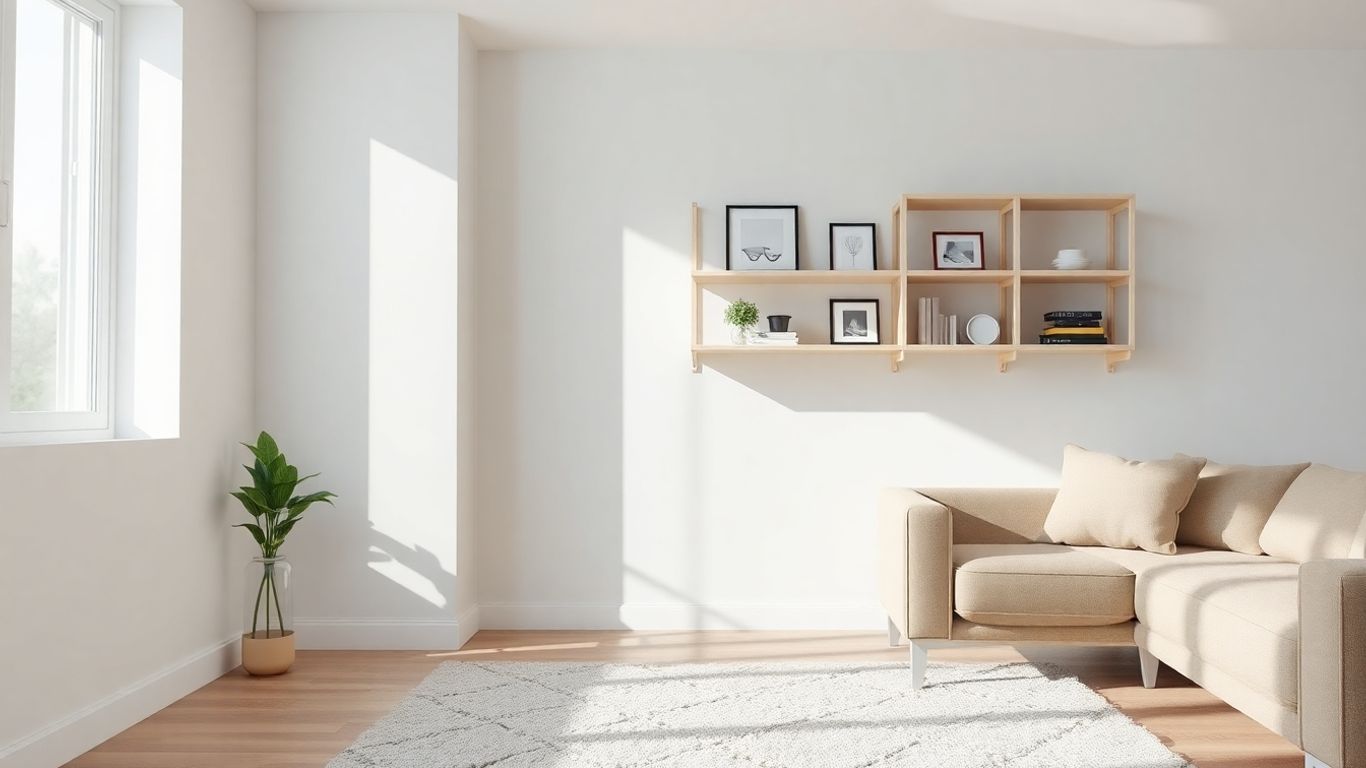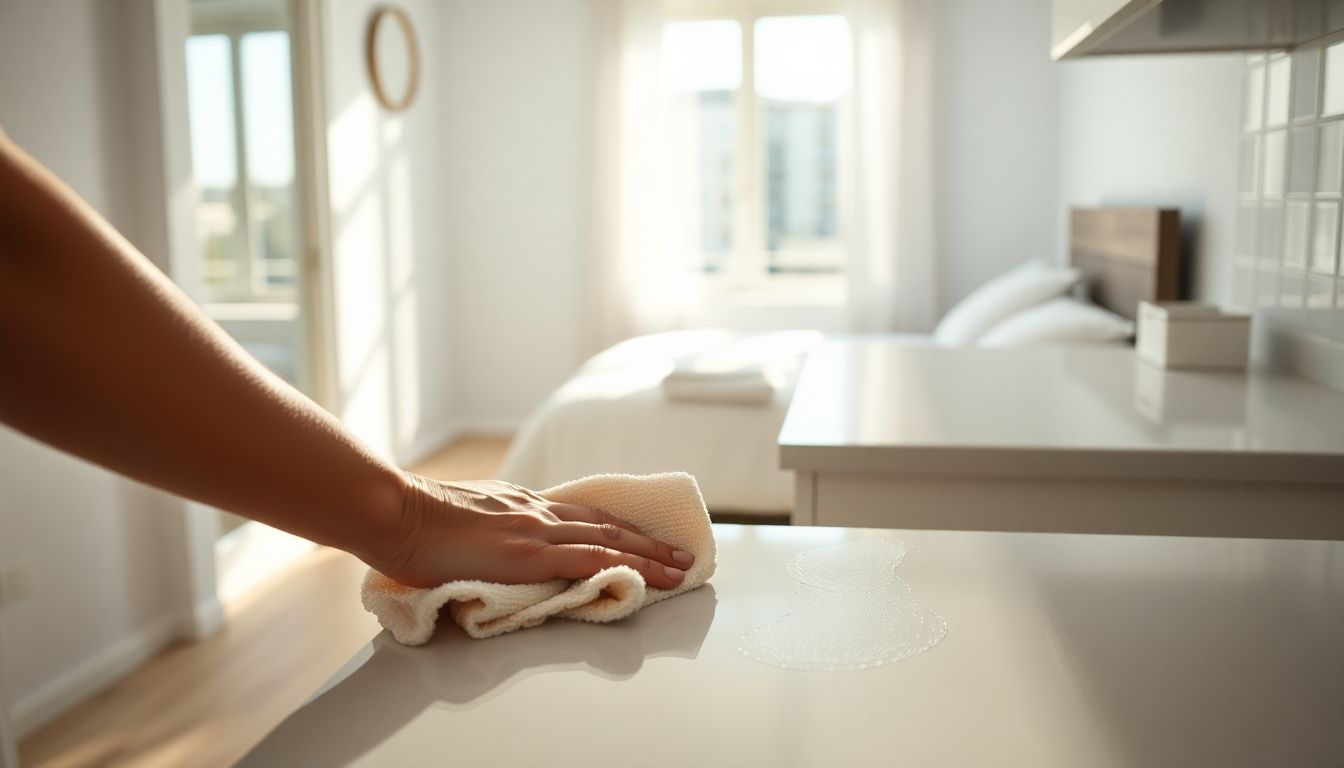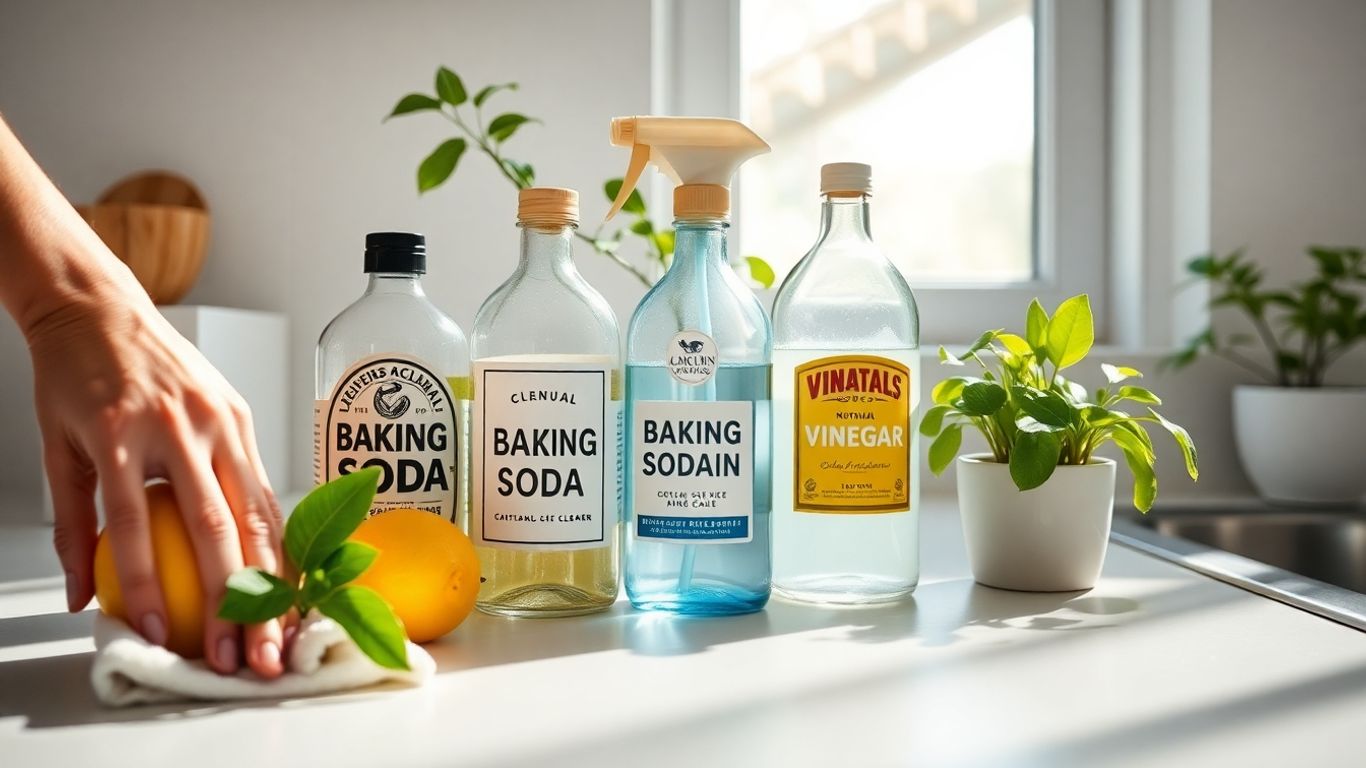Keeping your place in Raleigh tidy can feel like a lot, right? Between work, family, and just, you know, life, finding time to clean can be tough. But it doesn’t have to be this huge chore. Figuring out how to create a cleaning schedule that actually works for you is the trick. We’re talking about making it simple, fitting it into your life, and not feeling totally overwhelmed by it all. Let’s get your home looking good without adding more stress.
Key Takeaways
- Figure out what parts of your home get the most use and focus your cleaning efforts there first. Kitchens and bathrooms usually need more attention.
- Break down cleaning into small, manageable chunks: quick daily tidy-ups, more thorough weekly tasks, and less frequent monthly deep cleans.
- Use tools like phone apps or a simple calendar to keep track of what needs doing and when. Set reminders so you don’t forget.
- Don’t try to do too much too soon. Start with realistic goals and gradually build up your cleaning routine. It’s okay if it’s not perfect.
- When life gets crazy or a task feels too big, don’t be afraid to call in professionals for a deep clean or regular help. It can save you time and hassle.
Understanding Your Home’s Cleaning Needs
Before you even think about grabbing a mop or dusting cloth, it’s smart to take a moment and really look at your home. Not all houses, or the people living in them, are the same, right? What works for one family might be totally different for another. So, let’s figure out what your place actually needs to stay tidy and comfortable.
Assessing High-Traffic Areas
Think about where people, pets, and general life happen the most in your home. These are your high-traffic zones. The entryway, the kitchen floor, the living room where everyone gathers – these spots probably get dirtier faster and need more attention. You might want to give these areas a quick tidy-up more often than, say, a guest bedroom that’s rarely used. Keeping an eye on these busy spots can prevent small messes from becoming big headaches.
Considering Your Household’s Lifestyle
Are you a family with young kids and pets constantly tracking in who-knows-what? Or maybe you work from home and need a calm, clean workspace? Your daily routine plays a huge role. If you’re always on the go, you’ll want a schedule that fits into small pockets of time. If you have more flexibility, you might be able to dedicate longer blocks for cleaning. It’s all about making the cleaning work for you, not the other way around.
Prioritizing Tasks for a Tidy Home
Not all cleaning tasks are created equal. Some things, like wiping down the kitchen counters after cooking, are daily necessities. Others, like cleaning out the fridge or washing windows, can wait a bit. It helps to make a list and decide what’s most important to you right now. Maybe a clean bathroom is your top priority, or perhaps keeping the floors clear is key. Focusing on what matters most will make your home feel cleaner faster.
Creating a cleaning plan that fits your home and your life is the first step to a more organized and peaceful living space. It’s not about being perfect, but about making progress.
Here’s a simple way to think about task importance:
- Daily: Quick wipe-downs, tidying up main living areas.
- Weekly: Bathrooms, kitchen floors, dusting main rooms.
- Monthly: Baseboards, light fixtures, deeper appliance cleaning.
Remember, you can always adjust this as you go. If you find yourself needing more time for certain tasks or less for others, that’s perfectly fine. The goal is to find a rhythm that keeps your home feeling good. For more ideas on keeping your home in top shape, check out professional cleaning services that can help manage the load.
Structuring Your Cleaning Schedule
Okay, so you’ve thought about what needs cleaning, which is a great start. Now, let’s figure out how to actually get it done without feeling totally swamped. The trick here is breaking things down. Trying to do everything at once is a recipe for disaster, trust me. Instead, we’ll look at a few different levels of cleaning to make it manageable.
Daily Quick Wins to Prevent Bigger Jobs
These are the little things that take just a few minutes but make a huge difference. Think of them as your home’s daily maintenance. If you let these slide, you’ll end up with a much bigger mess later. It’s like not changing the oil in your car – eventually, something bad happens.
- Wipe down kitchen counters and the sink after meals. This stops food bits from sticking and makes your kitchen feel instantly cleaner.
- Make the beds. Seriously, it takes two minutes and makes your bedroom look so much tidier.
- Do a quick sweep or vacuum of high-traffic floor areas. Especially if you have kids or pets, this catches crumbs and dirt before they get ground in.
- Spend 5-10 minutes tidying up main living areas. Put away stray items, fold blankets, and generally just reset the space.
These small, consistent efforts are the secret sauce to preventing overwhelming cleaning tasks down the line. They keep the everyday clutter and grime at bay.
Weekly Deeper Dives for Key Areas
Once the daily stuff is handled, we can move on to the weekly tasks. These are the jobs that give your home a more thorough clean. You don’t need to spend all day doing this; you can spread them out or tackle them on a specific day. It really depends on what works for your life.
- Bathrooms: Scrub the toilet, shower/tub, sink, and mirrors. Don’t forget to mop the floor.
- Kitchen: Give the appliances a good wipe-down, clean the stovetop, and mop the floor.
- Floors: Vacuum carpets and rugs, and mop all hard floors throughout the house.
- Dusting: Go over surfaces like tables, shelves, and picture frames.
Monthly Tasks for Overlooked Spots
These are the jobs that don’t need doing every week but are important for keeping your home truly clean and well-maintained. If you only ever do daily and weekly tasks, these can get neglected, and then they become a big project.
- Windows: Give your windows a good wash, inside and out if possible.
- Baseboards: Wipe down all the baseboards. You’d be surprised how much dust collects there.
- Appliances: Clean out the inside of your microwave, dishwasher filter, and maybe even the fridge shelves.
- Light Fixtures and Vents: Dust or wipe down light fixtures and clean air vents.
By dividing your cleaning into these different frequencies, you create a system that feels less like a chore and more like a routine. It’s all about making your home a pleasant place to be without adding unnecessary stress.
Making Your Cleaning Schedule Work for You
So, you’ve got a plan, which is awesome! But how do you actually make it stick without feeling like you’re drowning in dust bunnies? It’s all about making the schedule work for you, not the other way around. Let’s break down how to do that.
Utilizing Digital Tools and Apps
Honestly, trying to remember everything can be a headache. That’s where technology swoops in to save the day. There are tons of apps out there designed specifically for managing household chores. Think of them as your personal cleaning assistant. Apps like Tody or Sweepy can send you reminders, let you create custom checklists, and even track your progress, which is pretty motivating.
If apps aren’t your jam, a simple digital calendar works wonders too. Google Calendar or even a shared family calendar can be set up with recurring tasks. You can assign specific days for certain jobs, like “Bathroom Blitz” on Saturdays, and set alarms so you don’t forget. It takes the mental load off trying to recall what needs doing next.
Setting Achievable Cleaning Goals
This is a big one. It’s super easy to get ambitious and create a schedule that’s impossible to follow. Then you feel guilty, and the whole thing falls apart. Instead, be real with yourself. How much time do you actually have each day or week to dedicate to cleaning? Start small.
Maybe your goal for the first week is just to tackle the kitchen counters daily and do one load of laundry. Once that feels easy, you can add more. It’s better to consistently do a little bit than to aim for a marathon and end up on the couch.
Consistency over perfection is the name of the game here. A clean-ish home done regularly is way better than a spotless home that only happens once a blue moon.
Incorporating Family into Chores
Keeping a house tidy shouldn’t fall on just one person’s shoulders. If you have a family, get everyone involved! It’s not just about getting help; it’s about teaching responsibility and teamwork. Even little ones can help with simple tasks like putting away their toys or wiping up spills.
Here’s a simple way to get started:
- Create a Chore Chart: Make a visual list of tasks and who is responsible for what. You can post it on the fridge.
- Rotate Tasks: To keep things fair and interesting, switch up chores every week or month.
- Make it Fun: Put on some music, turn it into a game, or offer small rewards for a job well done.
Remember, the goal is to create a shared sense of responsibility for your living space. It might take some initial effort to get everyone on board, but the long-term benefits of a cleaner home and a more cooperative household are totally worth it.
Tackling Those Less Obvious Cleaning Tasks
We all know the drill: wipe down counters, vacuum the floors, scrub the toilet. But what about those spots that seem to hide from view? These often-overlooked areas can make a big difference in how truly clean your home feels. Let’s shine a light on them!
Don’t Forget Windows and Baseboards
Windows can get pretty grimy, especially after a season of pollen or dust. Streaky windows can make a room feel dimmer and less inviting. For a streak-free shine, try a simple mix of water and a little white vinegar in a spray bottle. Wipe them down with a microfiber cloth or some old newspaper.
And baseboards? They’re dust magnets! A quick wipe with a damp cloth or a vacuum cleaner attachment can make them look like new. It’s amazing how much cleaner a room looks when the baseboards are fresh.
Reaching Behind Furniture and Under Appliances
This is where the real dust bunnies tend to gather. When you’re doing a more thorough clean, try to pull out furniture like sofas and chairs. Even just moving them a few inches can give you access to a surprising amount of dust and debris. The same goes for appliances like your refrigerator or washing machine. A quick sweep or vacuum behind and underneath can really help.
Think of these areas as the ‘hidden’ parts of your home’s cleanliness. Addressing them means you’re not just cleaning the surfaces you see every day, but truly tidying up.
Cleaning Vents and Light Fixtures
Air vents can accumulate a lot of dust, which then gets circulated around your home. A vacuum cleaner with a brush attachment is perfect for gently cleaning these. For light fixtures, make sure they are cool and turned off! A quick dusting with a microfiber cloth or a feather duster usually does the trick. For more stubborn grime on glass fixtures, you might need a damp cloth, but be sure to dry them thoroughly afterward to avoid water spots.
Efficient Time Management for Cleaning
Let’s be real, keeping a house clean can feel like a full-time job sometimes. You’re busy, life happens, and suddenly that dust bunny has evolved into a small mammal. The trick to staying on top of it without losing your mind is to get smart about how you spend your cleaning time. It’s not just about what you clean, but when and how you tackle it.
Setting Aside Specific Time Blocks
Instead of letting cleaning tasks pile up until you have a weekend-long marathon, try carving out dedicated time slots. Think of it like scheduling an important appointment. Even 15-30 minutes a day can make a huge difference. For those less frequent but important jobs, like cleaning out the fridge or scrubbing the oven, block out a specific hour once a month. This way, these tasks don’t get forgotten.
- Daily: 15-30 minutes for quick tidies (wiping counters, quick sweep of high-traffic areas).
- Weekly: 1-2 hours for more thorough tasks (bathrooms, vacuuming, mopping).
- Monthly: 2-3 hours for deeper cleaning (windows, baseboards, appliances).
Breaking down your cleaning into manageable chunks prevents overwhelm and makes the whole process feel less daunting. It’s about consistency, not intensity.
Giving Priority to Overlooked Areas
We all have those spots that tend to get ignored – the tops of cabinets, behind the couch, light fixtures, or air vents. These areas can become major dust collectors and impact your home’s air quality. Make a point to rotate these less obvious tasks into your weekly or monthly schedule. You might be surprised what you find!
- Dusting ceiling fans and light fixtures.
- Wiping down baseboards and door frames.
- Cleaning air vents and return grilles.
- Reaching behind and under appliances.
Creating a Cleaning Timetable
A visual aid can be a game-changer. Whether it’s a simple whiteboard, a printable chart, or a digital app, having a clear timetable keeps you accountable. You can list daily, weekly, and monthly tasks and check them off as you go. This visual progress can be surprisingly motivating!
Consider a method like the “6-minute clean, 10-minute break” if you find it hard to focus for long stretches. It breaks the work into short, achievable bursts, making it easier to get through your list without feeling completely drained.
When to Call in Professional Help
Let’s be real, sometimes life just gets in the way, and keeping up with a cleaning schedule can feel like a full-time job on top of everything else. It’s totally okay to admit that you can’t do it all yourself, and that’s where calling in the pros comes in handy. They’re there to help make your life a little easier and your home a lot cleaner.
Scheduling Regular Maintenance Cleanings
If you find yourself constantly playing catch-up or just don’t have the bandwidth for weekly tidying, regular maintenance cleanings are a lifesaver. Think of it like a standing appointment for your home. A cleaning service can come in weekly, bi-weekly, or monthly, depending on what works for you. They’ll handle the usual suspects: dusting surfaces, vacuuming, mopping, and giving your bathrooms and kitchen a good scrub. This keeps things from getting out of hand and means you don’t have to stress about the everyday upkeep.
Opting for Deep Cleaning Services
There are those tasks that just seem to linger on the to-do list forever, right? Windows, baseboards, behind the fridge – you know the drill. Deep cleaning services are perfect for tackling these less frequent but super important jobs. Professionals have the right tools and know-how to get into those nooks and crannies that are tough to reach. It’s a great way to reset your home’s cleanliness and get those areas that often get overlooked sparkling again.
Finding Tailored Cleaning Solutions
Every home and every family is different. Maybe you have a new baby and need extra help with sanitizing, or perhaps you’re preparing for a big party and want your place to shine. Professional cleaning companies can often customize their services to fit your specific needs. You can talk to them about what’s most important to you, whether it’s focusing on allergy-friendly cleaning, dealing with pet messes, or just getting a specific room extra clean. It’s all about finding a service that fits your life and your home’s unique requirements.
Sometimes, the best way to maintain a clean and comfortable home is to accept that you don’t have to do every single chore yourself. Bringing in professionals for specific tasks or regular upkeep can free up your time and mental energy, allowing you to focus on other things you enjoy.
Staying Flexible with Your Cleaning Routine
Life happens, right? You’ve made this awesome cleaning schedule, and you’re ready to rock it. But then, unexpected guests show up, the dog gets sick, or maybe you just have one of those days where the couch is calling your name. That’s totally okay! A cleaning schedule is a guide, not a dictator. The whole point is to make your home feel more comfortable and manageable, not to add stress.
Adjusting Your Plan as Needed
It’s smart to build a little wiggle room into your plan. If you miss a day or a task gets pushed back, don’t sweat it. Maybe you swap your usual Tuesday dusting for a quick kitchen wipe-down because that’s what feels most important that day. Or perhaps you decide to tackle the baseboards next week instead of this week because you’re just not feeling it. It’s all about what works for you and your household.
Here are a few ways to roll with the punches:
- Reschedule: If a task gets missed, simply slot it into another day or week. Maybe combine it with a similar task to save time.
- Prioritize: Some days, you might only have energy for the absolute essentials. Focus on those high-impact areas like the kitchen counters or the main bathroom.
- Simplify: If you’re really short on time, break down a larger task into smaller, more manageable steps. Dusting the living room can become just dusting the coffee table and TV stand for now.
Focusing on Consistency Over Perfection
Trying to hit every single item on your list every single week can lead to burnout. It’s much better to be consistently doing a decent job than to aim for a perfect clean once and then give up because it felt too overwhelming. Think of it like this:
A little bit of cleaning done regularly makes a much bigger difference in the long run than trying to do a marathon cleaning session every few months.
So, if you only manage to do half of your planned tasks one week, that’s still progress! The goal is to keep things generally tidy and prevent major messes from accumulating.
Maintaining a Comfortable Living Environment
Ultimately, your cleaning schedule should serve your life, not the other way around. If your schedule is making you feel rushed or guilty, it’s time to rethink it. Maybe you need to simplify the tasks, delegate more, or even consider bringing in professional help for certain jobs. The aim is to create a home that feels welcoming and pleasant for everyone living in it. If your current routine isn’t achieving that, don’t be afraid to tweak it until it does.
Wrapping Up Your Raleigh Cleaning Routine
So there you have it! Creating a cleaning schedule for your Raleigh home doesn’t have to feel like a huge chore itself. By breaking things down, figuring out what needs doing when, and maybe even getting the family involved, you can totally get a handle on keeping your place tidy. Remember to be kind to yourself if things don’t go perfectly every single day – life happens! The main thing is having a plan that works for you and makes your home a more comfortable spot to be. Happy cleaning!
Frequently Asked Questions
How often should I clean different parts of my house?
You can break down cleaning into daily, weekly, and monthly tasks. Quick daily clean-ups like wiping counters and tidying up can prevent bigger messes. Weekly tasks might include vacuuming, mopping, and cleaning bathrooms. Monthly chores could involve washing windows or deep cleaning appliances.
What are considered ‘high-traffic’ areas in a home?
High-traffic areas are the spots in your home that get used the most. Think of your kitchen, living room, and main hallways. These areas usually need cleaning more often because they tend to get dirtier faster.
Is it okay to hire professional cleaners?
Absolutely! Hiring professional cleaners is a great option, especially if you’re short on time or need help with deep cleaning. Many services offer regular cleanings or one-time deep cleans to fit your needs.
How can I make cleaning less overwhelming?
To make cleaning less overwhelming, try breaking tasks into smaller steps and setting realistic goals. Using digital tools or apps can help you stay organized, and involving your family in chores can lighten the load.
What are some cleaning tasks people often forget?
It’s easy to forget things like cleaning windows, baseboards, or vents. Also, don’t forget to clean behind furniture or under appliances where dust can build up. These less obvious spots are important for a truly clean home.
How can I manage my cleaning time better?
To manage your cleaning time efficiently, set aside specific blocks of time for tasks, especially those that don’t need doing every week. Prioritize areas that get overlooked and create a simple timetable or checklist to keep you on track.





